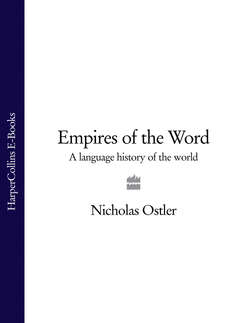Читать книгу Empires of the Word: A Language History of the World - Nicholas Ostler - Страница 40
Dealing with foreign devils
ОглавлениеFrom the sixteenth century until the present day, the Chinese government has increasingly come into contact with Japan and a series of European powers, culminating in the first approaches of the USA; these resulted in wars, and the planting of foreign communities in trading colonies. For overseas Chinese communities, the effects were complex: they sometimes suffered from China’s measures aimed at impoverishing and disarming foreigners; but they also profited from opportunities that were provided by the foreigners’ enterprising new developments, especially those of Britain.
In the early sixteenth century, Japanese pirates were a persistent problem. China imposed an embargo on Japan. For good measure, in 1522 it also banned all commercial voyages to the Nan-yang, converting all overseas Chinese into smugglers or pirates. Meanwhile, European explorers were increasingly nosing about China’s seas, looking for trading concessions. In 1557 the Portuguese were granted an enclave on the coast at Macao; this turned out to be sufficient to fob off their intrusions in the long term. But it added a further burden to the overseas Chinese, who seemed now to be at a disadvantage even as against the dastardly European folangji;* the ban on Chinese voyages to the Nan-yang was finally lifted in 1566.
Although the advent of the Spanish and Dutch, following the Portuguese, provided capacious new markets for the now long-resident Chinese traders of the East Indies, lack of clear support from China meant that Chinese traders were always at a disadvantage. In Luzon, in their newly Spanish colony of the Philippines, the Chinese population was massacred in 1602 and again in 1639, with utter impunity. Nevertheless, the trader community was beginning to be seen as a useful force: when the Ming dynasty was toppled by the Manchus in 1644, the last loyalist strongholds were found in the maritime communities of Zhejiang, Fujian and Guangdong, and later, until 1682, offshore in Vietnam and the Philippines. They suffered for their loyalty, of course, with the Manchus literally ‘clearing the coasts’ of all their inhabitants, moving them miles inland to prevent any support to mariners. Perhaps also—since the Manchu invaders through victory became the legitimate authority, the Qing dynasty—they laid the basis for a certain distrust felt ever since by China’s central government towards its overseas community. This was the seed time for the Chinese Triads, and secret societies.
But there were new forces loose in the Nan-yang, and the Chinese were ready to profit from them. When Europeans were banned from Thailand in 1688, the Chinese became its principal traders and economic consultants through the eighteenth century. They were also well ensconced in the Malay kingdom of Johore. But in the same era, they found abundant opportunities for profit in collusion with the new Dutch VOC (East India Company); so much so that they suffered another major massacre at Dutch hands, in Java in 1740. And when the British started their own East Indian enterprise, on the empty Malayan island of Penang in 1785, it was the Chinese who volunteered to populate it. Likewise, they were in the forefront in Raffles’ development of Singapore after 1819. As British power spread across Malaya and northern Borneo, and the Dutch interest farther south, into Sumatra, southern Borneo and Celebes, the Chinese interests accompanied them. They liked very well the British institution of free ports.
Pressure was now building up from trading interests in France and Britain on China itself. The French concern centred on Chinese possessions in Vietnam, but the British dealt more directly, and fiercely, with the Qing government, in defence of their opium trade out of Bengal: the result was the cession of Hong Kong (1842, enlarged in 1860 and 1898) and foreign access to five more treaty ports, including Shanghai (1842). Although the most prominent of these were not in Fujian, their classic recruiting area, the overseas Chinese now had guaranteed access to the mainland. Links grew, and for the first time since the seventeenth century direct involvement with the mainland became an important part of overseas Chinese trade. Nan-yang was coming home.
